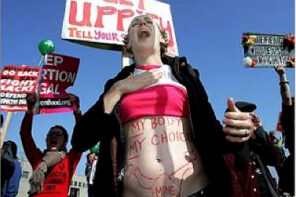As expected, religious-right groups are already touting a study released this week that indicates abstinence-only education, if done right, may work at encouraging students to delay becoming sexually active. The results, they say, are vindication that chastity-until-marriage programs can work. Tony Perkins of the Family Research Council issued a statement saying, “This study tells us clearly that abstinence education, not the promotion of high-risk sexual behavior among teens, is needed.”
Not so fast, Mr. Perkins.
While the results merit further analysis, reproductive rights advocates are cautioning the public that one study does not discount 30 years of reproductive research that shows that sound science-backed comprehensive programs that teach contraception and sexually transmitted disease prevention remain critical to preventing teenage pregnancy and the spread of STDs.
The study, “Efficacy of a Theory-Based Abstinence-Only Intervention Over 24 Months,” was published in the February issue of Archives of Pediatrics and Adolescent Medicine, and indicates that abstinence education successfully reduced self-reported sexual involvement among African-American students in grades six and seven.
The findings go against the results of previous studies that indicate federally funded abstinence-only programs do not work. It also comes on the heels of last week’s announcement that teen pregnancy rates increased during the Bush era of abstinence-only sex education.
In the study, students were randomly assigned to one of five different programs, which included an eight-hour curriculum that encouraged them to delay having sex; an eight-hour program focused on teaching safe sex; an eight- or 12-hour program that did both; or an eight-hour program focused on teaching them other ways to be healthy, such as eating well and exercising, which served as the control group.
Of the students who completed the programs and who had not been sexually active before the class, 33 percent of those in the abstinence program self-reported having had sex 24 months later, compared to 52 percent of the students who had taken the safer-sex program and 47 percent who had taken the health control.
However, before politicians start yelling for public school-sponsored chastity balls, it’s important to note that the abstinence program in the study differs from the Bush-era “abstain until marriage” programs supported by Perkins and other Christian conservatives, but which were determined to be ineffective. As the new study points out, the abstinence program didn’t encourage teens to wait to have sex until marriage, but rather to delay sex until they’re ready, an important distinction:
The 8-hour abstinence-only intervention encouraged abstinence to eliminate the risk of pregnancy and STIs including HIV. It was designed to (1) increase HIV/STI knowledge, (2) strengthen behavioral beliefs supporting abstinence including the belief that abstinence can prevent pregnancy, STIs, and HIV, and that abstinence can foster attainment of future goals, and (3) increase skills to negotiate abstinence and resist pressure to have sex. It was not designed to meet federal criteria for abstinence-only programs. For instance, the target behavior was abstaining from vaginal, anal, and oral intercourse until a time later in life when the adolescent is more prepared to handle the consequences of sex. The intervention did not contain inaccurate information, portray sex in a negative light, or use a moralistic tone. The training and curriculum manual explicitly instructed the facilitators not to disparage the efficacy of condoms or allow the view that condoms are ineffective to go uncorrected.
And as researchers made clear, such types of education may not necessarily be effective with a population older than the young teens and pre-teens who participated.
Advocates for Youth, a reproductive rights organization, makes some good points to consider. Almost one-quarter of the young people in the study were already sexually active when the programs began.
This is the problem with the “only” component of any “only-type” program. An abstinence-only program provides no information about condoms and contraception even though, in this case, approximately one-quarter of the young people in the intervention already had had sex.
The advocacy group also cites previous research on virginity pledges that demonstrate the initial delays in sexual activity do not last and half of all teens are sexually active by 17.
There is good research showing that many comprehensive sex education programs—programs that provide information about both abstinence and contraception/condoms—are effective at helping young people delay sexual initiation as well as at using contraception/condoms when they do become sexually active. Thirty years of public health studies have clearly determined that the provision of information about condoms and contraception does not increase sexual activity among teens or lower the age of sexual initiation.
I think pretty much everyone agrees that it’s in the best interest of 12- and 13-year-olds for them not to be sexually active. But the results from this one study, of course, need to be looked at carefully in a broader context. Also, any such program taught in public schools must be in keeping with the First Amendment’s Establishment Clause and may not endorse a religious view.




